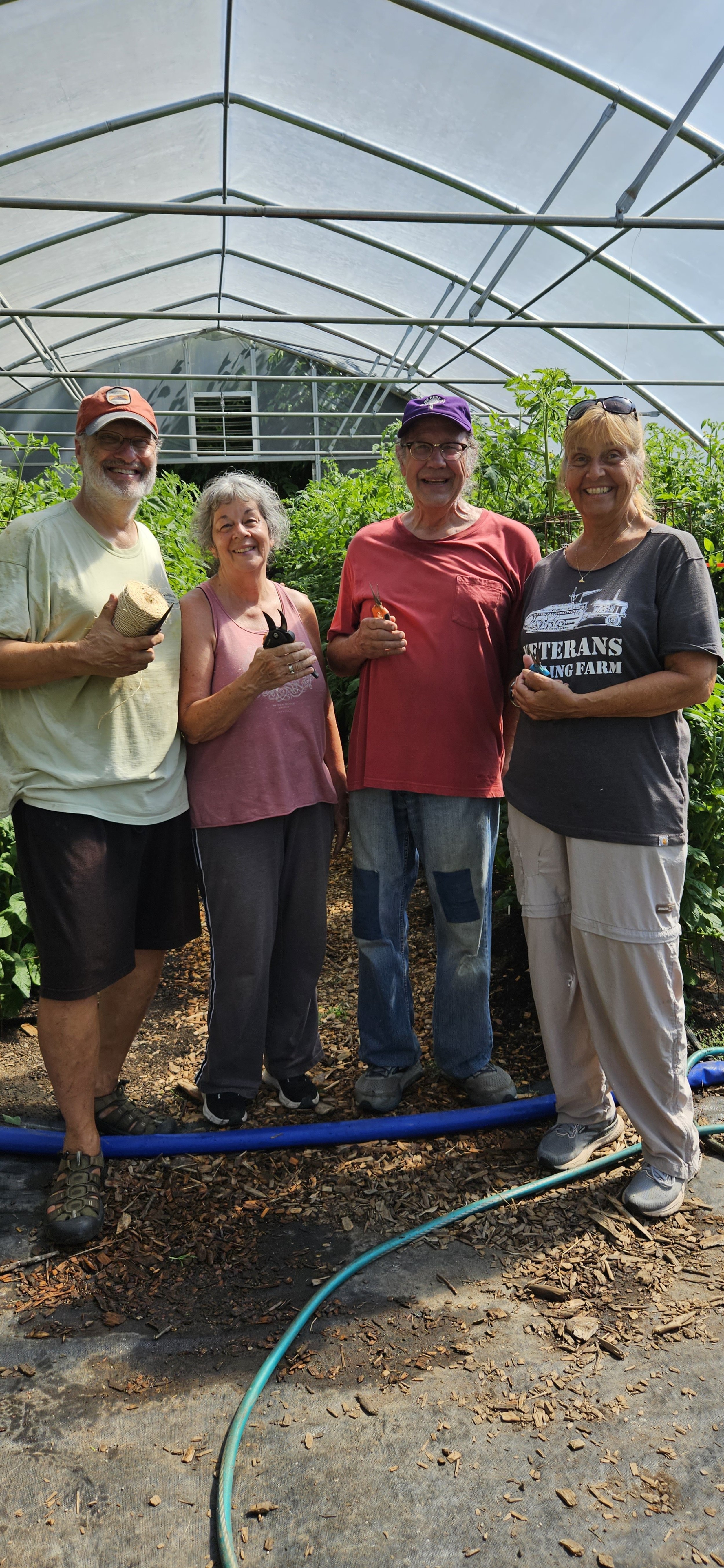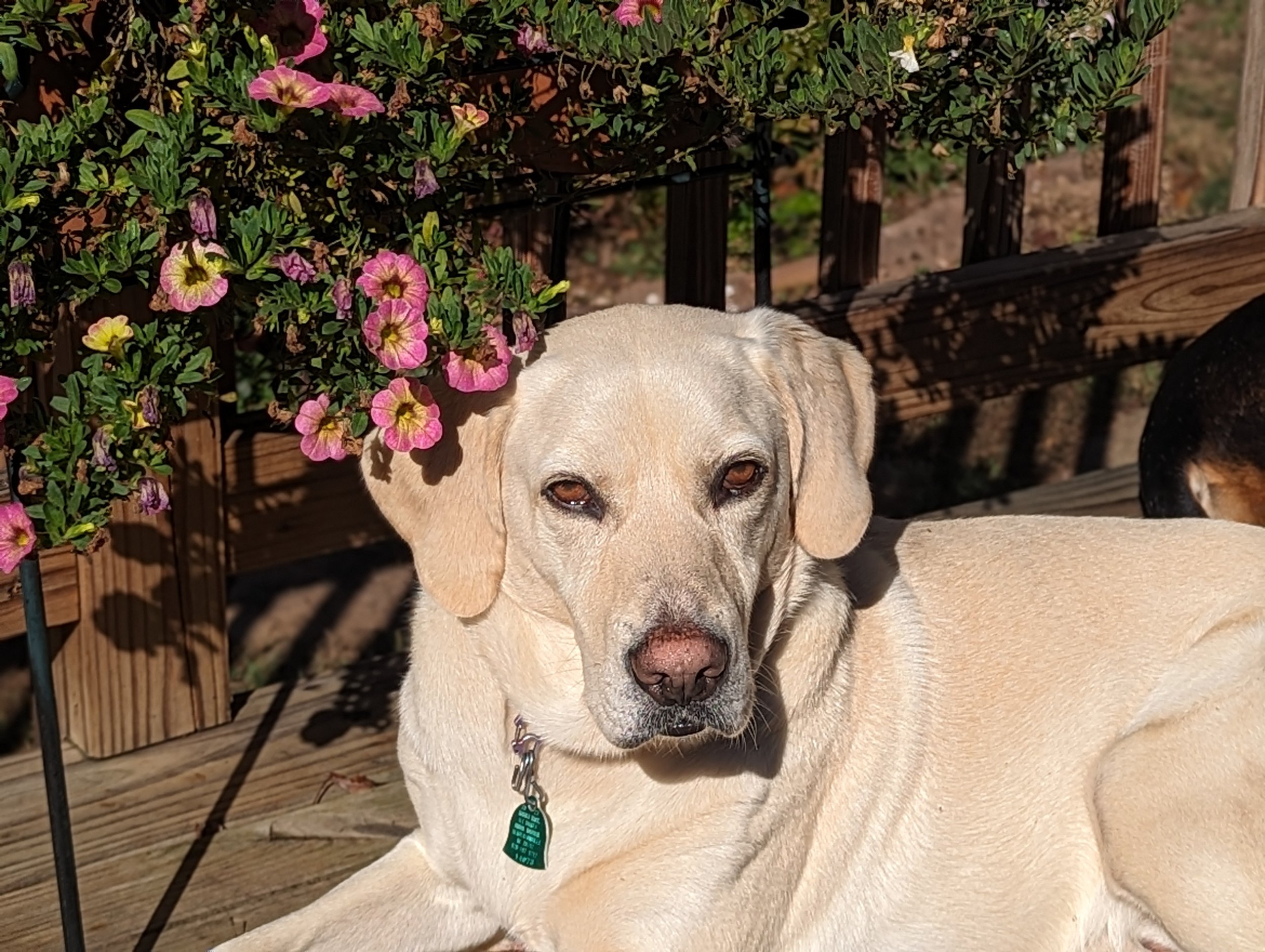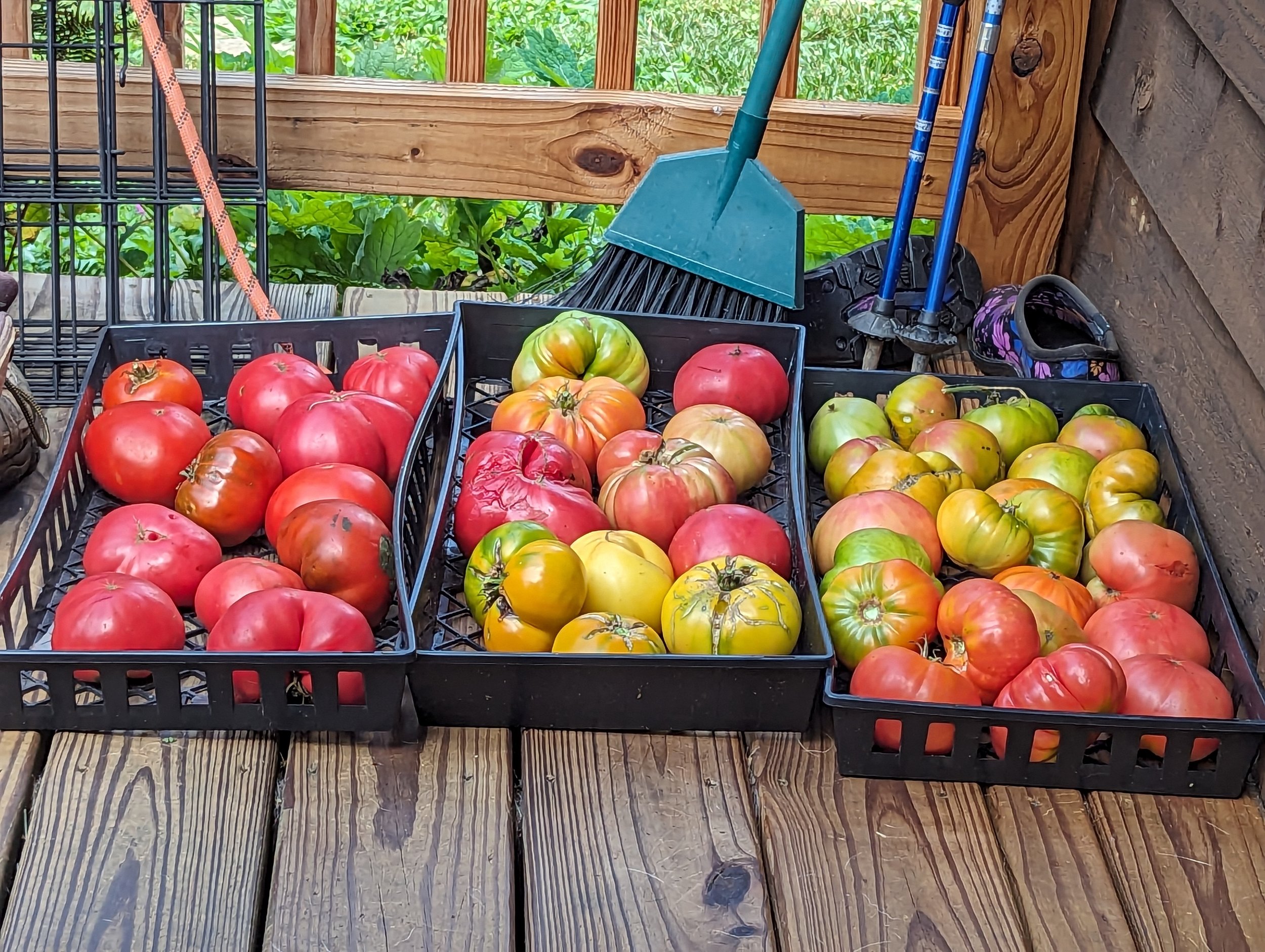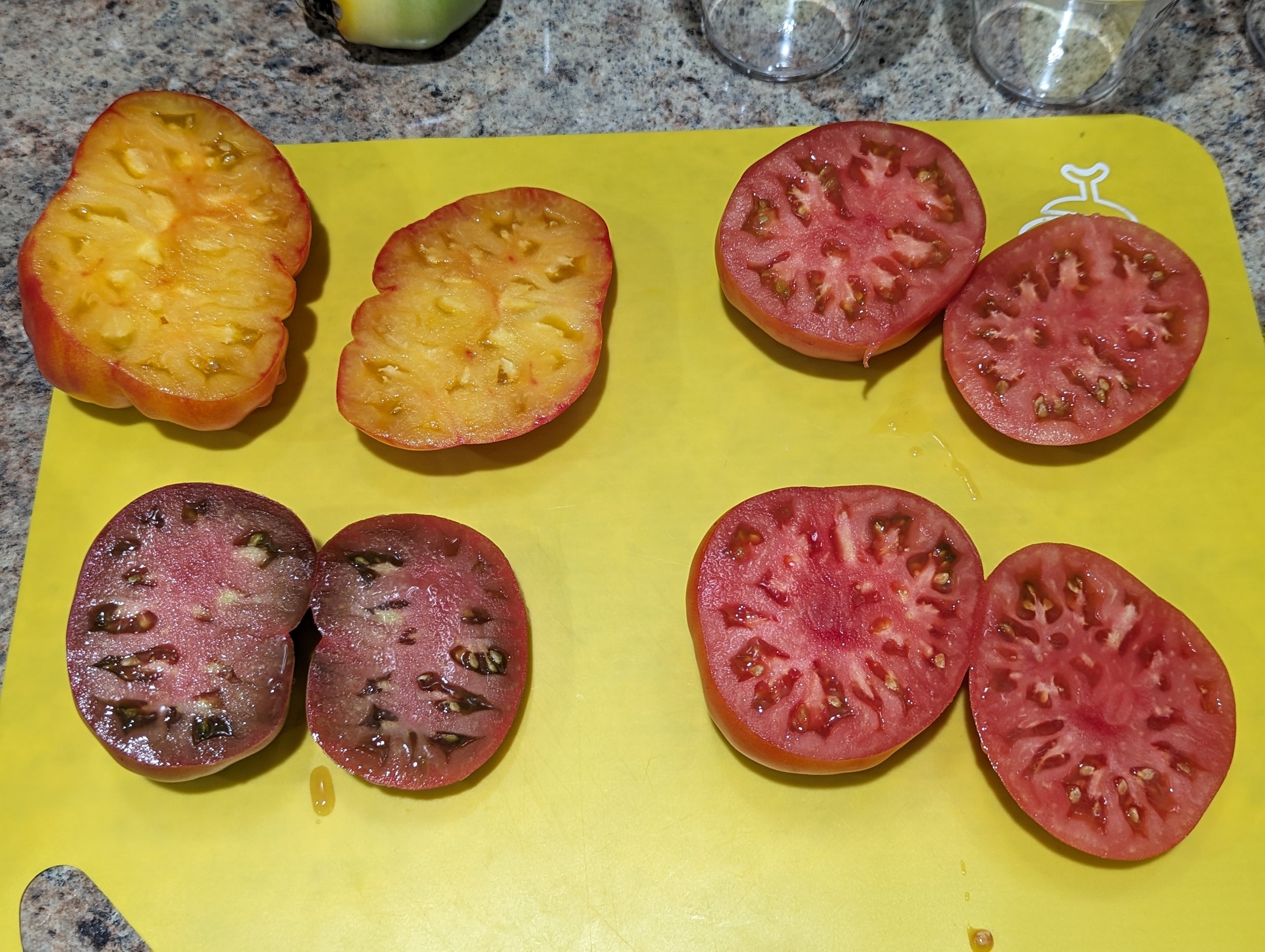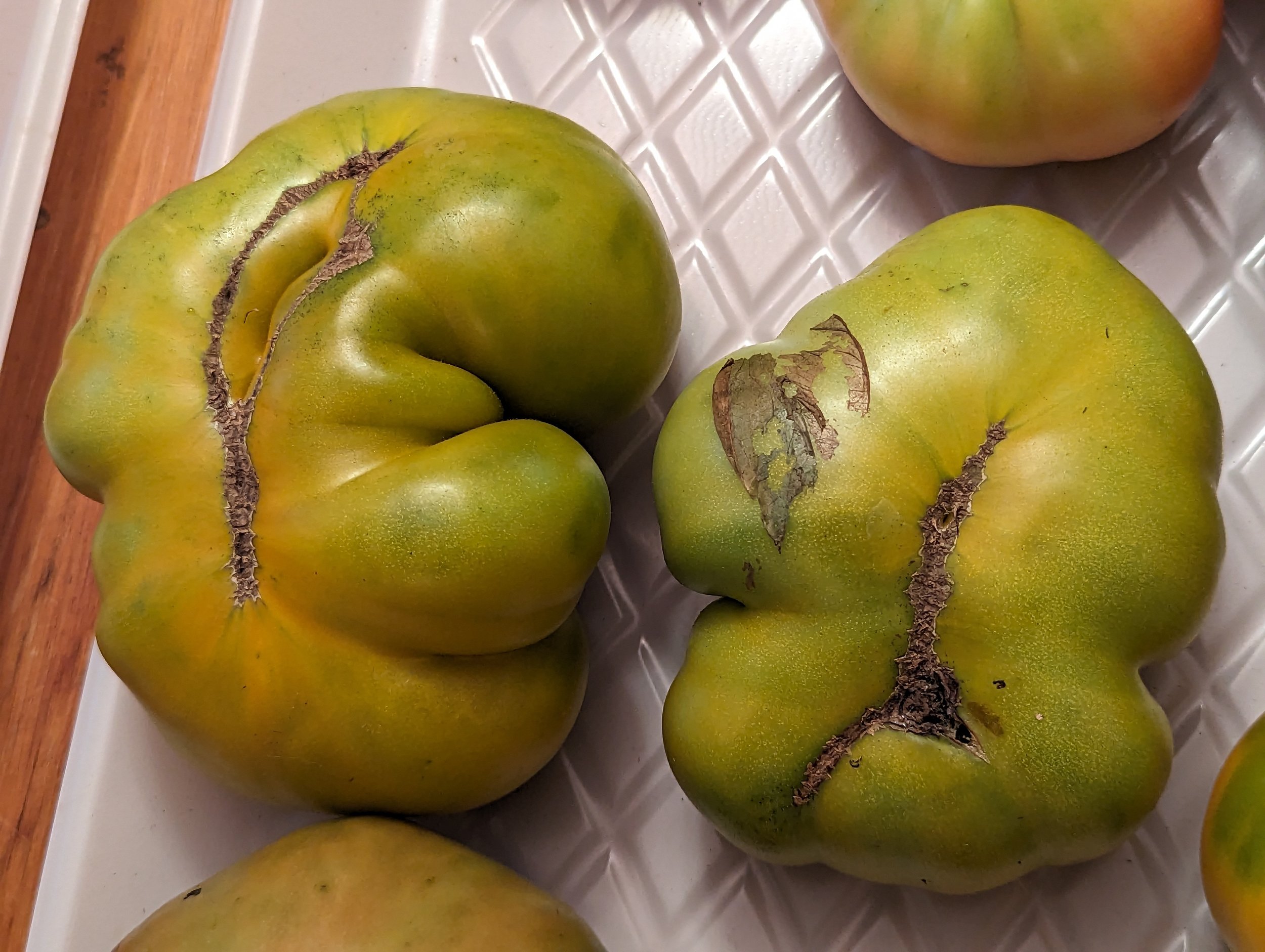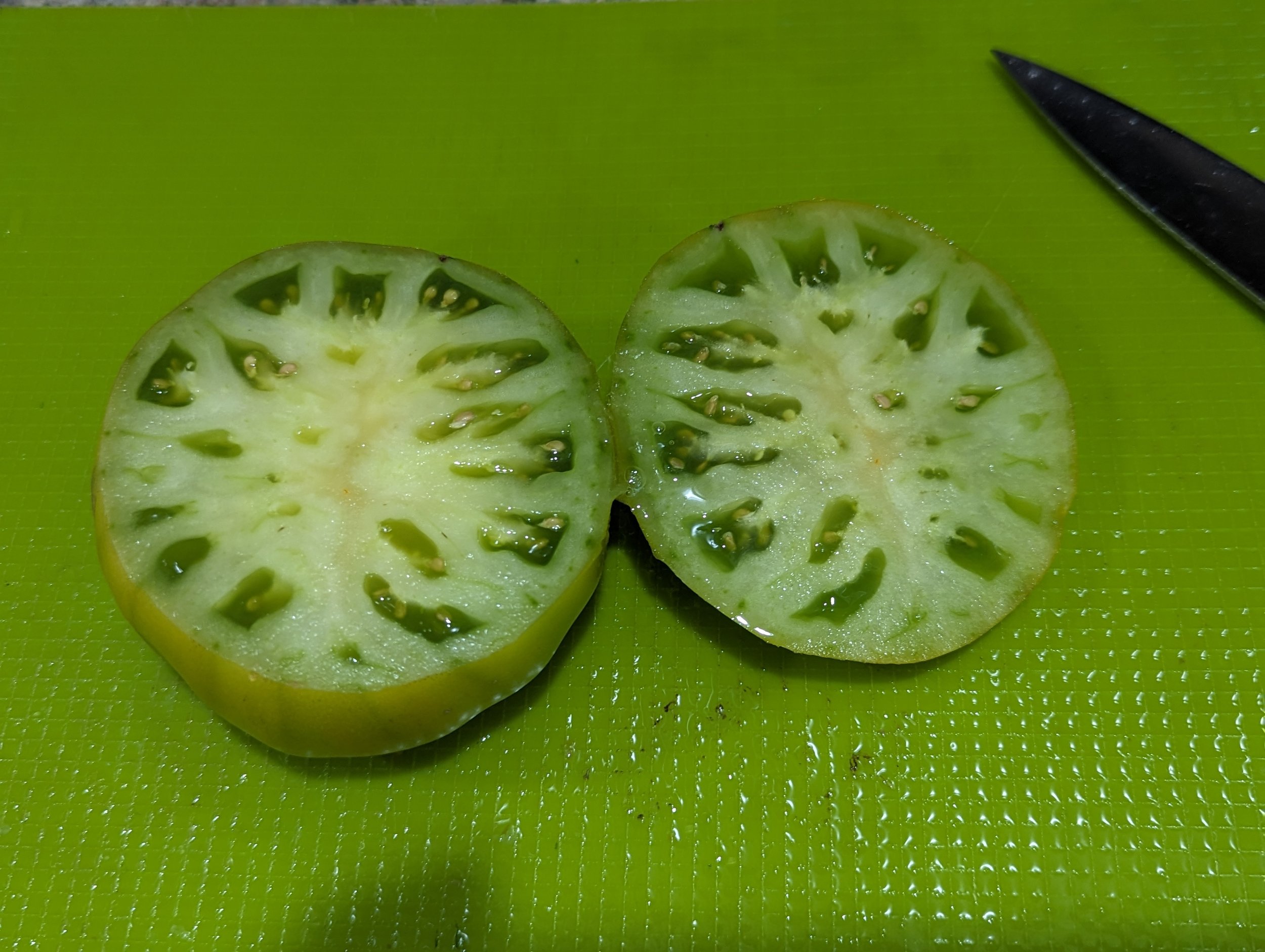August view of the VHF greenhouse plants
Moving right along with my updates, I will now discuss the indeterminate varieties that we grew in the Veterans Healing Farm greenhouse. Alas, my picture taking was not good at all, so this and the next blog will be more about descriptions and my ratings and reviews.
Fairytale Fee - #7893 - Plant died with either collar rot or pith necrosis prior to bearing any fruit.
Fairytale Elf - #7881 - This was a tomato machine and one of the best of the Kleverhof varieties. The medium sized, slightly plum shaped fruit were light and dark green striped on the outside, and green fleshed on the inside, with a nice mildly sweet flavor. Seed saved as T23-128
Fairytale Snack - #7878 - I grew this in my home garden as well as in the greenhouse and performance was the same - lots of 1 ounce flattened, ribbed, partly hollow snacking tomatoes that ripened orange and had a pleasant sweet flavor. Seed saved as T23-129
Fairytale Glanz - #7879 - very prolific bearing large pink cherry tomatoes with gold stripes, quite firm, mild flavor. Pretty, but not really a flavor winner. Seed saved as T23-130
Fairytale Fruit - #7911 - prolific, healthy, and a real surprise! The fruits varied in size from 3 oz to hear one pound, and oblate to round to a few approaching heart shapes. Color was yellow with red swirls, flesh tender and pleasant in texture. The flavor was quite outstanding - certainly one of the best bicolors i’ve eaten. This one is highly recommended. For my palate, this is the best of the Kleverhof releases. Seed saved as T23-131.
Fairytale Angel - #7895 - certainly the most prolific of the Kleverhof varieties, as well as one of the most beautiful, the small plum shaped tomatoes ripen nearly pure white with a true light violet shading on the shoulder. The flavor is mild and on the sweet end of things. Seed saved as T23-132.
Lillian Rose - T22-15 - This is what I was hoping for in growing Lillian Rose. The one in my back yard was more pink, larger and oblate - this one was pink with some yellow, more round, and more delicious. I consider this a lead for the new variety. The potato leaf plant is indeterminate but on the more compact end of things, and the high yield was produced quite late in the season. Seed saved as T23-133
Big Sandy - T22-67 - This grew identical to the one in my back yard - medium to large scarlet red beefsteak type tomatoes with an excellent flavor, produced prolifically. Seed saved as T23-134
Monticello Mystery Tomato - T19-112 - The mystery of this is that it originated from a seed found in excavated soil near the kitchen location of Monticello and shared with me in 2013. The highly irregular, wrinkled, ribbed and ridged tomatoes can grow quite large, up to one pound. The flavor is quite good. This tomato gives us a peek into what tomatoes looked like growing in the mid 1800s as they made their way here from Europe. Seed saved as T23-135.
Polish - T22-7 - Reliably excellent, the potato leaf plant produced large pink tomatoes with outstanding flavor, just as expected. Seed saved as T23-136,
Cancelmo Family Heirloom - T20-15. The very tall, spindly plant produced medium to large meaty pink heart shaped tomatoes with an excellent flavor. Seed saved as T23-137.
Giant Syrian - T21-16 - The very tall, spindly plant produced medium to large scarlet red heart shaped tomatoes with excellent flavor. Seed saved as T23-138.
Monticello Mystery Tomato - #5125 - Growing identically to that from saved seed listed above, this was grown from seed given to me by the staff at Monticello back in 2014. Seed saved as T23-139.
Andrew Rahart’s Jumbo Red - T19-13. The plant grew fine, producing large scarlet red tomatoes. Alas, I wasn’t available to do a harvest when it was on the vine and ready to pick, so all of the tomatoes ended up being given away. I didn’t get a chance to save any seeds.
Fritsche Family - #7797 - This favorite from many years ago didn’t disappoint. The tall vigorous plant produced a heavy yield of medium sized nearly round pink tomatoes with an excellent flavor balanced to the sweet side. It is likely a family selection from one of the popular tomatoes of the time, such as Livingston’s Beauty. Seed saved as T23-141.
Cherokee Green X Caitlin’s Lucky Stripe F2 RL - T21-11 - I don’t have good records on this - “pink with gold stripes” and didn’t note size or flavor. It came to ripeness in the avalanche of so many others. Seed saved as T23-142.
Hugh's - T13-13 - This plant grew enormously and yielded heavily. The monstrous pale yellow tomatoes were oblate in shape and approached 2 pounds. The flavor is mild, sweet and pleasant. Seed saved as T23-143.
Giant Syrian - T13-138 - This was one of the first plants to suffer from disease, apparently pith necrosis, and the plant was pulled. I did snip a 6 inch growing tip that seemed healthy and rooted it at home. It grew in the strawbale in my yard that was used for snap bush beans, and ended up producing a heavy yield of medium to large scarlet red heart shaped tomatoes that came on too late to vine ripen. They were brought indoors, put into a bag with a ripe apple, and seed was saved as T23-140.
Stocky’s - #7747 - This rare variety was sent to me by a gardening friend in New Zealand. The spindly plant produced a good yield of large pink heart shaped fruits. I didn’t care for the flavor, which was too mild for my palate - the tomatoes were also very solid with few seeds. It would make a splendid sauce tomato. Seeds saved as T23-145
Marlowe Charleston - T22-68 - This variety is supposedly a potato leaf, pink fruited heirloom from West Virginia. My friend Adam gave me a fruit from the plant he grew in his 2022 garden. The seedlings were all regular leaf - the tomatoes medium sized, smooth, pink and very tasty. It has been clearly crossed along the way, but this regular leaf, smaller fruited version is a fine tomato. Seed saved as T23-146
TBT - #7780 - Here’s a fun mystery. A gardening friend sent me seeds of this variety - TBT stands for “The Best Tomato”. Curious, I decided to grow it and was amazed to see the size of the fruit. The large pink slightly heart shaped variety was the largest in the greenhouse, approaching 2 pounds. It was very meaty and firm, with few seeds, and a mild sweet flavor. It is supposedly a West Virginia heirloom and could be related to another huge variety growing in the greenhouse, McCutcheon, given to me by my friend Adam. He is working to untangle the history and relationship of the two varieties. Seed saved as T23-147
Kosovo - Tomato Growers Supply packet - Various friends have been suggesting I give this tomato a try for some years, so I finally got around to it. The plant didn’t produce as many tomatoes as I’d hoped, likely because it became shaded between other plants in the greenhouse. The tomatoes are heart shaped, medium sized or larger, pink and quite tasty, but I think it did not nearly show its best this year. Seed saved as T23-148
Hugh's - T21-30 - This magnificent tomato excelled in the greenhouse, providing huge pale yellow, sweet tomatoes approaching 2 pounds - and lots of them. Seed saved as T23-149
Nepal - T21-17 - This fairly ordinary scarlet red, nearly round medium sized tomato has been a favorite since I first grew it in 1987. It did very well growing in the greenhouse. Seed saved as T23-150
Abraham Lincoln from USDA - #7745 - My search for the Abraham Lincoln as described in the 1923 Buckbee catalog continues - this wasn’t it. The plants did not have a bronze tint, and the scarlet tomatoes were just medium in size. Seed saved as T23-151
Cherokee Purple Peregrine Farms selection - #6896 - I enjoyed growing out seeds from my friend Alex Hitt’s Peregrine Farms garden. He first received the seeds from me just after I named the variety and it has been a specialty of his ever since. I was curious to see if he selected for various traits that rendered it slightly different from the version I’ve been growing. I was delighted to find that it seemed quite identical to the ones from my saved seed. Production and flavor were excellent. Seed saved as T23-152
Eva Purple Ball - T16-75 - I wanted to regrow this favorite I first received as a seedling from Carolyn Male many years ago when I gardened in Raleigh. It produced very well, providing lots of medium sized smooth round pink tasty tomatoes. Seed saved as T23-153
Yellow Brandywine - T21-35 - I love Yellow Brandywine and it didn’t disappoint this year in the greenhouse - the oblate, 1 lb orange fruit were delicious with a nice tart tang. Seed saved as T23-154
Ferris Wheel - T21-25 - This long time favorite from the Salzer Seed Company (1894) has been a favorite ever since I rescued it from oblivion, from the USDA seed collection. It produced well in the greenhouse, providing lots of medium large to large oblate delicious pink tomatoes. Seed saved as T23-155
Aker's West Virginia - T21-27 - The plant grew well and produced large scarlet red tomatoes, but I didn’t get to harvest fruit for seed saving prior to harvest for giving the tomatoes away locally. No seed saved.
Andrew Rahart’s Jumbo Red - T21-20 - This large scarlet red beefsteak type that I’ve grown for many years did very well, providing medium large to large tasty tomatoes. Seed saved as T23-157
Casey's Pure Yellow - T20-14 - This favorite bright yellow excelled in the greenhouse, with an excellent yield of large, tasty tomatoes. It has been a favorite for quite a few years. Seed saved as T23-158
Lillian's Yellow Heirloom - T20-10 - This favorite of mine clearly enjoyed being grown in the Veterans Healing Farm greenhouse. Yield of the large, oblate, super delicious bright yellow tomatoes was excellent. Seed saved as T23-159
Lucky Cross - T20-4 - Quite a few Lucky Cross selections were grown in the greenhouse and all did great. This plant from recently saved seed produced a lot of large yellow tomatoes with red swirls and an excellent flavor. Seed saved as T23-160
Stump of the World - T20-12 - This produced as expected - large oblate tasty pink tomatoes on a potato leaf plant. Seed saved as T23-161
Large Lucky Red - T21-39 - This scarlet red, large fruited variant that showed up in a Lucky Cross planting performed as hoped - the tomatoes are really tasty! Seed saved as T23-162
Anna Russian - T21-29 - This long time favorite did very well, producing lots of medium sized pink hearts with a delicious balanced flavor. Seed saved as T23-163
JD Special C Tex - T19-2 - This is one of my favorite purple varieties - quite similar to Cherokee Purple except a bit more oblate. This plant did very well. Seed saved as T23-164
Cherokee Chocolate - T22-2 - This grew as anticipated, producing lots of medium to medium large oblate chocolate colored, delicious tomatoes. Seed saved as T23-165
Estler's Mortgage Lifter - T22-8 - Though the size was not as large as I hoped for, productivity of this historic, sweet, pink fruited variety was just fine. Seed saved as T23-166
Indian Stripe - T19-9 - The plant produced a very good yield of medium large, oblate, delicious tomatoes. Seed saved as T23-167
Brandywine - T18-4 - This performed as hoped - very good yield of spectacularly flavored pink oblate tomatoes. Brandywine never disappoints in terms of flavor - only occasionally in terms of yield. Seed saved as T23-168
Cherokee Purple - T22-3 - The plant produced a good yield of medium to large purple tomatoes that were true to type. Unfortunately, I didn’t get fruit for seed saving prior to the team harvesting and donating the tomatoes. No seed saved.
Blue's Bling X Polish F3 - T22-17 - My lead selection from my recent cross, which I will call Polish Bling, produced lots of medium large purple oblate fruit on a potato leaf plant that had white variegation. Flavor was excellent. Seed saved as T23-170
Hege's German - T16-78 - The plant did not do very well and when I did harvest a tomato it appeared to be scarlet, rather than pink. I never did get back in time to double check this, so no seed was saved from this plant.
Don’s Double Delight X Cancelmo Family Heirloom F2 RL - T21-8 - I didn’t get to harvest any tomatoes from this plant and didn’t visit the farm in time to see what the tomatoes looked like. No seed was saved from this plant.
Captain Lucky - T22-9 - This is simply a superb, prolific variety - the plant in the greenhouse was the equal to the one in my back yard. The green tomatoes with a pinkish purple blush and swirl are among the best tasting tomatoes of my entire gardening experience. Yield was outstanding. Seed saved as T23-173
Cancelmo Family Heirloom - T17-13 - This spindly, wispy plant (as expected) produced quite early and was prolific. The medium to large pink hearts were delicious. Seed saved as T23-174
Lucky Cross - T11-8 - This represents one of three older selections of Lucky Cross, and I grew them out to see if I could have a way to bump up the flavor (the most recent selection I typically grow seems to have lost some of the flavor intensity). The reselection mini project was a success - all three were just delicious. Seed saved as T23-175
Lucky Cross - T11-50 - This is another of my reselection work - see above for details. This plant did just great with lots of delicious large yellow tomatoes with red swirls. Seed saved as T23-176
Dester - T12-19 - The plant produced large oblate delicious pink tomatoes, as expected. Sadly, I didn’t get to the farm to harvest fruit for seed saving at the time it was available - all tomatoes were harvested and donated, so no seed was saved.
Hugh's - T14-27 - See the entry a bit above - this performed equally - huge bright yellow delicious tomatoes balanced to the sweet side. Seed saved as T23-178
Big Sandy - T13-130 - High yield, nice size, and delicious scarlet red tomatoes - this West Virginia heirloom should be more widely known - and grown. Seed saved as T23-179
Giant Syrian - T12-20 - The spindly plant with wispy foliage produced lots of medium to large scarlet red, delicious hearts. It is good to have fresh seed from this plant produced from 11 year old seed. Seed saved as T23-180
Lillian's Yellow Heirloom - T12-15 - Having tomatoes from 11 year old seed of this favorite variety makes me happy - the plant produced lots of large pale yellow superb tomatoes. Seed saved as T23-181
Indian Stripe - T11-94 - I was delighted to get 12 year old seed to germinate - the plant produced tomatoes that are very similar to Cherokee Purple, as expected. The medium large purple fruit were delicious. Seed saved as T23-182
Cherokee Chocolate - T12-72 - I was pleased to get 11 year old seed to germinate, allowing me to get fresh seed - the tomatoes were as expected - medium large, delicious and chocolate brick colored. Seed saved as T23-183
McCutcheon - T22-20 - This tomato, which may be related to TBT (see above), produced huge pink nearly round tomatoes with excellent flavor. Could it be also related to Mortgage Lifter? Seed saved as T23-184
Lucky Cross - T11-14 -see above - this is the third of my reselection effort for this favorite variety. It did great - potato leaf plant with lots of large oblate yellow tomatoes with red swirls - and outstanding flavor. Seed saved as T23-185
Gallo Plum - #7749 - One of the tomatoes I got from West Virginia gardener Charlotte Mullens in 1990 (along with Big Sandy and the family’s Mortgage Lifter), I finally returned to growing this excellent scarlet red large fruited paste tomato. The lanky, wispy vines produced lots of tomatoes that resemble a frying pepper, similar to varieties such as Opalka. The flavor is excellent. Seed saved as T23-186
Dester - T18-2 - This variety, a favorite, grew as hoped for - good yield of large pink oblate tomatoes with superb flavor. Seed saved as T23-187
Cancelmo Family Heirloom - T16-98 - The tall spindly plant produced a heavy yield of large, pink heart shaped tomatoes, as expected. Unfortunately, I didn’t get to the greenhouse to harvest a few fruit for seed saving in time prior to the plant being completely harvested. No seed was saved.
JD Special C-Tex - T12-8 - This variety produced as expected, with a very good yield of medium to large, oblate, firm purple tomatoes with an excellent flavor. With the same color and very similar flavor to Cherokee Purple, this by comparison produces a more flattened, oblate tomato. Seed was saved as T23-189.
Little Lucky - T20-18 - this was a replacement plant and due to its highly shaded location (surrounded by more mature, taller plants), never did produce any tomatoes before going down to disease.
Dorothy's Green - #7746 - the greenhouse plant was equivalent to the one in my back yard garden. This former favorite produced a high yield of irregular, oblate, medium to large fruit with green flesh and a yellow skin. The flavor is very good. The propensity to produce irregular fruit is quite prominent in this colorful variety. Seed was saved as T23-191.
Cherokee Green X Caitlin’s Lucky Stripe F2 potato leaf - T21-11 - I was delighted to get a good sized oblate pink tomato with excellent flavor and no sign of stripes. It isn’t a high priority lead, but an excellent eating tomato. This Seed saved as T23-192.
Don’s Double Delight X Cancelmo Family Heart F2 potato leaf - T21-8 - My record keeping is not good for this one - all I have on my seed envelope is potato leaf heart, with no indication of color or striping. Seed saved as T23-193
Ferris Wheel X Striped Sweetheart F2 - T21-2 - I didn’t mark down leaf shape - the medium sized pink tomatoes were very good flavored at best, not excellent. Seed saved as T23-194
Don’s Double Delight X Cancelmo Family Heart F2 regular leaf - T21-8 - This ended up producing large red hearts, but I didn’t note the flavor. Seed saved as T23-195.
Summary - This was a LOT of work - and it generated a lot of information. What was best about the experience of growing in the Veterans Healing Farm greenhouse was working with a team - getting to share these wonderful varieties. The array of colors and sized and flavors, and richness of history, really opened the eyes of my volunteers.
It was also very valuable to get fresh seeds from some quite old seeds of many of my favorite varieties. Overall I was pleased with the results. The main issue was learning that different diseases can hit tomatoes grown in this way. The production was over a very concentrated period, and the plants needed to be pulled far sooner than we would have liked.
Me with some of my wonderful tomato team - Joanne, Phillip and Grace



